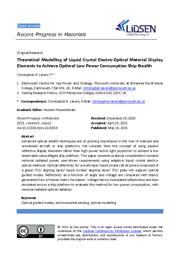A copy of this work was available on the public web and has been preserved in the Wayback Machine. The capture dates from 2021; you can also visit the original URL.
The file type is application/pdf.
Theoretical Modelling of Liquid Crystal Electro-Optical Material Display Elements to Achieve Optimal Low Power Consumption Ship Stealth
2020
Recent Progress in Materials
Advanced optical stealth techniques are of growing importance in the role of manned and unmanned aircraft or ship platforms. We consider here the concept of using passive reflective display elements rather than high power active light projection to achieve a low observable camouflaged ship platform. This paper presents practical consideration towards minimal radiated power user-driven requirements using adaptive liquid crystal electro-optical methods. Optical reflectivity for a multi-layer
doi:10.21926/rpm.2102019
fatcat:435miztprzfg5jn42zekjwp5ia

